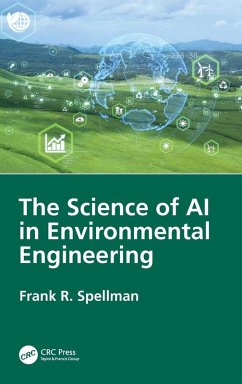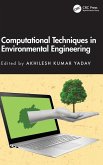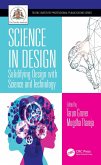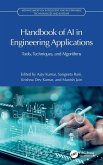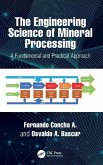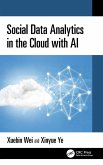Frank R. Spellman
The Science of AI in Environmental Engineering
Frank R. Spellman
The Science of AI in Environmental Engineering
- Gebundenes Buch
- Merkliste
- Auf die Merkliste
- Bewerten Bewerten
- Teilen
- Produkt teilen
- Produkterinnerung
- Produkterinnerung
This book explores the integration of AI in environmental engineering, emphasizing the unique challenges and approaches required for accurate modeling of physical phenomena.
Andere Kunden interessierten sich auch für
![Computational Techniques in Environmental Engineering Computational Techniques in Environmental Engineering]() Computational Techniques in Environmental Engineering170,99 €
Computational Techniques in Environmental Engineering170,99 €![The Climate Change-Agricultural-Environmental Nexus The Climate Change-Agricultural-Environmental Nexus]() The Climate Change-Agricultural-Environmental Nexus163,99 €
The Climate Change-Agricultural-Environmental Nexus163,99 €![Science in Design Science in Design]() Tarun GroverScience in Design213,99 €
Tarun GroverScience in Design213,99 €![Handbook of AI in Engineering Applications Handbook of AI in Engineering Applications]() Handbook of AI in Engineering Applications204,99 €
Handbook of AI in Engineering Applications204,99 €![The Engineering Science of Mineral Processing The Engineering Science of Mineral Processing]() Fernando Concha AThe Engineering Science of Mineral Processing186,99 €
Fernando Concha AThe Engineering Science of Mineral Processing186,99 €![The Science of Global Warming Remediation The Science of Global Warming Remediation]() Mark HarrisThe Science of Global Warming Remediation95,99 €
Mark HarrisThe Science of Global Warming Remediation95,99 €![Social Data Analytics in the Cloud with AI Social Data Analytics in the Cloud with AI]() Xuebin WeiSocial Data Analytics in the Cloud with AI107,99 €
Xuebin WeiSocial Data Analytics in the Cloud with AI107,99 €-
-
-
This book explores the integration of AI in environmental engineering, emphasizing the unique challenges and approaches required for accurate modeling of physical phenomena.
Produktdetails
- Produktdetails
- Verlag: CRC Press
- Seitenzahl: 430
- Erscheinungstermin: 23. April 2025
- Englisch
- Abmessung: 240mm x 161mm x 28mm
- Gewicht: 807g
- ISBN-13: 9781032989501
- ISBN-10: 1032989505
- Artikelnr.: 72175004
- Herstellerkennzeichnung
- Libri GmbH
- Europaallee 1
- 36244 Bad Hersfeld
- gpsr@libri.de
- Verlag: CRC Press
- Seitenzahl: 430
- Erscheinungstermin: 23. April 2025
- Englisch
- Abmessung: 240mm x 161mm x 28mm
- Gewicht: 807g
- ISBN-13: 9781032989501
- ISBN-10: 1032989505
- Artikelnr.: 72175004
- Herstellerkennzeichnung
- Libri GmbH
- Europaallee 1
- 36244 Bad Hersfeld
- gpsr@libri.de
Frank R. Spellman, Ph.D., is a retired assistant professor of environmental health at Old Dominion University, Norfolk, Virginia, and the author of more than 160 books covering topics ranging from concentrated animal feeding operations (CAFOs) to all areas of environmental science and occupational health. Many of his texts are readily available online, and several have been adopted for classroom use at major universities throughout the United States, Canada, China, Europe, South Korea, and Russia; two have been translated into Spanish for South American markets. He has been cited in more than 1,150 publications. He is a professional expert witness for three law groups and an incident/accident investigator for the U.S. Department of Justice and a northern Virginia law firm. In addition, he consults on homeland security vulnerability assessments for critical infrastructures, including water/wastewater facilities nationwide. He conducts nationwide pre-Occupational Safety and Health Administration (OSHA)/Environmental Protection Agency EPA audits. He receives frequent requests to co-author with well-recognized experts in several scientific fields; for example, he is a contributing author of the prestigious text The Engineering Handbook, 2nd ed. (CRC Press). He lectures on sewage treatment, water treatment, homeland security lectures, and safety topics throughout the country and teaches water/wastewater operator short courses at Virginia Tech (Blacksburg, Virginia). He holds a BA in Public Administration, a BS in Business Management, an MBA, and an MS and a PhD in Environmental Engineering
Part I The Foundation Chapter 1 The Digital Enlightenment Chapter 2 The
Digital Professional Chapter 3 Fundamentals of Environmental Engineering
Chapter 4 The Environmental Engineer's Toolbox Part II Applications and
Impacts Chapter 5 Water Supply and Treatment Chapter 6 Water Resource
Management Chapter 7 Wastewater Treatment Chapter 8 Air Pollution
Management and Monitoring Chapter 9 Environnemental Impact Assessment and
Mitigation Chapter 10 Waste Management Engineering Chapter 11 Forestry and
Agriculture Chapter 12 Green Energy Chapter 13 Land Surveying Chapter 14
Biotechnology Chapter 15 Environmental System Modeling Chapter 16
Industrial Hygiene Part III Conclusion Chapter 17 Data Center Limiting
Factors
Digital Professional Chapter 3 Fundamentals of Environmental Engineering
Chapter 4 The Environmental Engineer's Toolbox Part II Applications and
Impacts Chapter 5 Water Supply and Treatment Chapter 6 Water Resource
Management Chapter 7 Wastewater Treatment Chapter 8 Air Pollution
Management and Monitoring Chapter 9 Environnemental Impact Assessment and
Mitigation Chapter 10 Waste Management Engineering Chapter 11 Forestry and
Agriculture Chapter 12 Green Energy Chapter 13 Land Surveying Chapter 14
Biotechnology Chapter 15 Environmental System Modeling Chapter 16
Industrial Hygiene Part III Conclusion Chapter 17 Data Center Limiting
Factors
Part I The Foundation Chapter 1 The Digital Enlightenment Chapter 2 The
Digital Professional Chapter 3 Fundamentals of Environmental Engineering
Chapter 4 The Environmental Engineer's Toolbox Part II Applications and
Impacts Chapter 5 Water Supply and Treatment Chapter 6 Water Resource
Management Chapter 7 Wastewater Treatment Chapter 8 Air Pollution
Management and Monitoring Chapter 9 Environnemental Impact Assessment and
Mitigation Chapter 10 Waste Management Engineering Chapter 11 Forestry and
Agriculture Chapter 12 Green Energy Chapter 13 Land Surveying Chapter 14
Biotechnology Chapter 15 Environmental System Modeling Chapter 16
Industrial Hygiene Part III Conclusion Chapter 17 Data Center Limiting
Factors
Digital Professional Chapter 3 Fundamentals of Environmental Engineering
Chapter 4 The Environmental Engineer's Toolbox Part II Applications and
Impacts Chapter 5 Water Supply and Treatment Chapter 6 Water Resource
Management Chapter 7 Wastewater Treatment Chapter 8 Air Pollution
Management and Monitoring Chapter 9 Environnemental Impact Assessment and
Mitigation Chapter 10 Waste Management Engineering Chapter 11 Forestry and
Agriculture Chapter 12 Green Energy Chapter 13 Land Surveying Chapter 14
Biotechnology Chapter 15 Environmental System Modeling Chapter 16
Industrial Hygiene Part III Conclusion Chapter 17 Data Center Limiting
Factors

